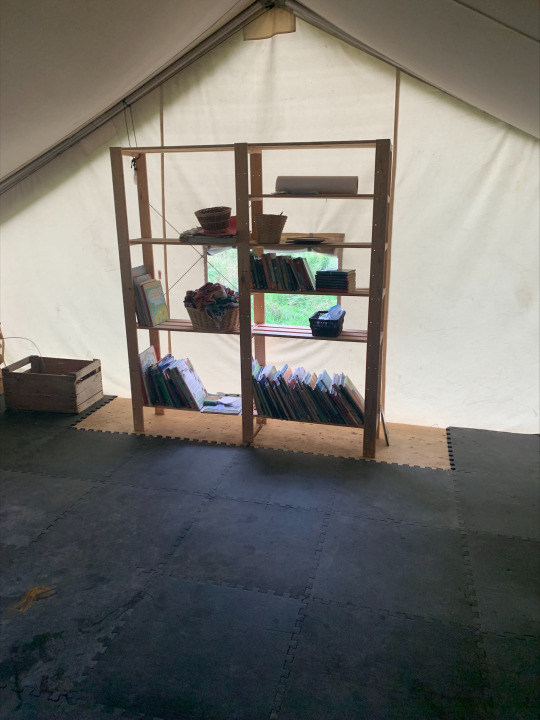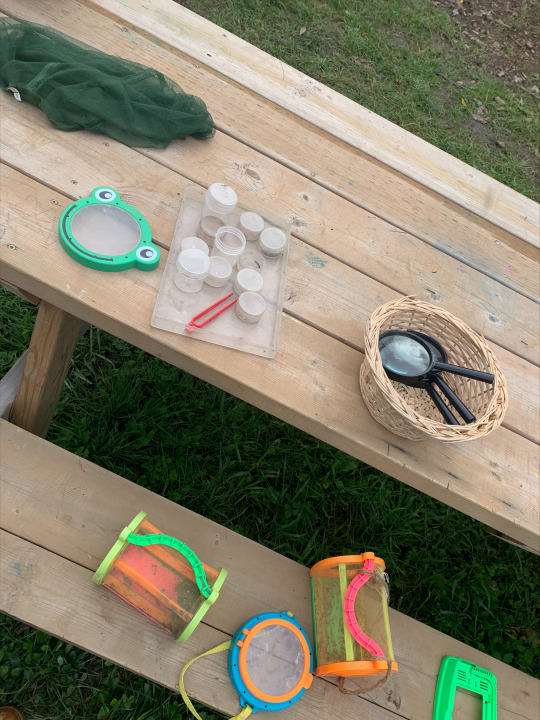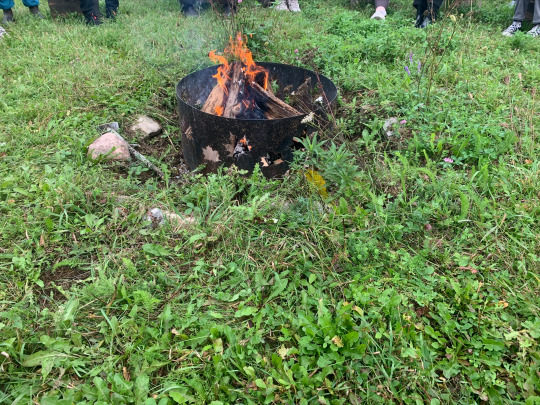Welcome to my neck of the woods! 2nd Year ECE student sharing my academic journey.
Don't wanna be here? Send us removal request.
Text




Geometry Workshop
Choose one activity from the Workshop that is appropriate for infants; explain why it is appropriate for infants and the learning involved.
Out of all the interesting activities we completed as part of our geometry workshop, one learning experience stands out in my mind as being appropriate and valuable for infants. The activity pictured in the last image – filling containers of various sizes with sand – would be my choice for infant learning. This activity is developmentally appropriate for infant children who have the physical skills (the core strength to sit or stand, and the gross motor skills to raise and pour cups of sand) to complete this activity but are not yet cognitively developed enough to be bored of this simple sensory learning experience. Infants will learn spatial awareness, and begin to understand concepts like volume, weight, and measuring, as they experiment with pouring and filling the containers. This activity will help them to learn object permanence and for older infants, activities like this set the foundation for learning reversibility.
2. Choose one activity from the Workshop that is appropriate for preschool aged children; explain why it is appropriate for preschool children and the learning involved.
For preschool aged children, I would choose the mystery-shape-matching-game featured in the first image. The objective of the learning experience is to have a group of children take turns reaching into the mystery box, feeling for a shape, grasping it, and then describing the physical properties of the shape without revealing it, so that the other children must guess what shape they are holding. When the answer is guessed correctly, the shape is pulled out of the box and matched to its card. This activity is perfect for preschoolers who are typically far enough along their learning trajectory to name common shapes and identify them based on their physical properties. The cognitive development necessary for this learning experience is present by preschool, and the children benefit from practicing their socioemotional skills – taking turns (moving from parallel play to cooperative), listening to others and expressing their own feelings/ideas in a small group. The mystery-shape-matching-game will challenge preschoolers to expand on their knowledge of geometry, while also practicing socioemotional skills which will serve as they progress farther along the learning trajectory.
7 notes
·
View notes
Text




Data displays are tools to support children’s learning by visually illustrating mathematical concepts. Data displays can be used to introduce numerical concepts such as greater than / less than, building on children’s counting skills along with 1:1 correspondence. Data displays invite children to use the language of math, as they build comparison skills in relation to numbers and quantities. At Station #7 my group explored ten-frames, a type of data display that is a bit more advanced than the basic 5 frame (which is perfect for beginners). We brainstormed different ways that Educators can use the ten-frame to expand their children’s learning from the beginner-level number sense skills they developed with the five-frame.
Both five and ten-frames are excellent tools to be utilized for early math learning – however, they are appropriate for different levels of learning and skill development. The five-frame is more appropriate for young children who are just beginning to develop an understanding of math concepts like numerical sense and rote counting. The five-frame supports children’s early learning because it builds a good foundation for more advanced concepts to branch off, without confusing the child by overwhelming them with too much at once. By looking at the five-frame, children will learn conceptual subitizing and practice 1:1 correspondence. The ten-frame is appropriate for children who already understand foundational math concepts and are prepared to take their learning to the next level. Working with the ten-frames teaches children rational counting, patterning recognition and extension, sequence, seriation, and perceptual subitizing.
0 notes
Text




My experience participating in various activities for Workshop 5 helped to illustrate what it is like to go through the engineering process, from a child’s perspective. Each activity offered an opportunity to work through the engineering steps we discussed in our class notes, but for this reflection I’ll be expanding upon how the Tower Cup Game supports the engineering process (refer to the first two images containing blue and red solo cups).
What is the problem?
My group of 4 students were tasked with the challenge of building the highest tower we possibly could with the red and blue solo cups.
Brainstorm Ideas
We immediately got to brainstorming ideas of how we should proceed. We pooled our knowledge from previous experience building towers of cups, discussing the best strategy to create a structure that was both tall and stable.
Design / Invent
We ultimately settled on a pyramid-style design. A solid foundation composed of a grid of double-stacked cups on the bottom, with increasingly narrow layers of stacked cups in a grid formation on top.
Build / Create
We built our tower of cups (see second image) with a colour-coded system in place. First blue, then a red layer, then another blue. We chose the pattern not only for the aesthetic appeal (it was quite pretty when we were finished) but also because it helped us stay organized as we progressed through the steps of the engineering process.
Test and evaluate
Once our tower was built to a sufficient height, we were prepared to measure it. The movements we made trying to measure the tower sent it crumbling to the ground, and we discovered our design was not as sturdy as we had originally hoped it would be. Back to the drawing board, we needed a new idea.
Re-Design / Modify design
We had a secondary brainstorming session and came up with a new strategy to re-design our tower for maximum heigh and structural stability. This time, we decided to simply stack as many cups as we could on top of each other, creating a single post-like structure (see first image). I successfully measured our re-designed tower, counting 33 clothespins high.
Share solution with others
We documented our progress and final product, sharing photos and submitting our thoughts through the learning experience in our individual reflections.
0 notes
Text




Workshop 4: Reflection
Choose your favorite activity from Workshop #4 and discuss what age group the experience is appropriate for and why.
My favourite activity from Workshop #4 was the ‘make your own salt-doh’ station. I believe that this learning experience would be appropriate for older preschool and kindergarten-age children; it is developmentally appropriate for children in that age group who are now at a stage where they can participate in ‘making’ the recipe in a meaningful way. Senior preschool and kindergarten-age children are cognitively developed to the point that they can follow simple directions in the recipe and can quantify ingredient amounts. They are still developing their fine-motor skills and this learning experience does not require a lot of fine-motor movement, but I would argue that this activity supports the development of gross-motor skills (standing at the table for an extended period of time, walking while holding measuring cups of ingredients to practice balance, etc). I would also stake the claim that this activity promotes parallel play – children are able to complete this activity individually, with the guidance of an Educator, but since they are all working on the same project, it creates a sense of co-operation and collaboration. They are working on the same thing, but separately. Lastly, although typically children have outgrown the infantile stage of exploring the world by putting everything in their mouths, even if the children did try to eat the salt-doh, the product is non-toxic and would not be harmful to indigest. Just a little gross.
How does the experience support children’s science learning? Give two (2) examples
This experience supports children’s science learning in multiple ways:
The children are exposed to scientific and mathematic vocabulary. Just as expanding a child’s art vocabulary leads to more creativity, giving the children tools to express their scientific curiosities empowers them to ask more questions. New concepts and words like mixing substances together to see a ‘chemical reaction’, explaining what a ‘hypothesis’ is, narrating how to ‘make observations’ aloud, and having group discussions about the ‘outcome of the experiment’ all support children’s science learning.
This experience supports children’s science learning by introducing a formula they can now follow and implement about their own curiosities, going forwards. As mentioned in my last example, narrating the scientific inquiry process to the children is not only exposing them to new words and ideas, but literally handing them a pattern to support their developing curiosities. As we discussed in class – sometimes a more affective way to support children’s curiosity and science learning is to not answer their questions, but to show them ways in which they can find answers for themselves. Perhaps after finishing the ‘make your own salt-doh’ activity, the Educator could restate the scientific inquiry method and invite children to make connections – “What is a question you have that we could find an answer to using the scientific inquiry method?”.
0 notes
Text




On Wednesday, September 21st, my class took a field trip to Out to Play Farm & Forest School. I absolutely adore the idea of a Forest School. In fact, it was my passion for outdoor education which partially motivated me to start the Early Childhood Education program at Algonquin, in the first place!
On the morning of our trip, students were lead on a brief walk through the woods by one of the Educators, a woman named Lara, until we came to a clearing in the wilderness. We were in a field; I noticed a green house looking building in the background and a firepit surrounded by logs. We gathered in a circle around the firepit while Lara introduced us to the concept of a Forest school, and what an average day in the program was like for the children who attended.
After our circle time, we followed Lara on a tour of the grounds. I noticed a puddle of muddy water with a plank across it, it intrigued me, so I snapped a picture. I wondered why there was a plank over the puddle, was it there to prevent the children from falling, or had a child placed it there intentionally so that they could practice balancing walking across it?
We continued, and I noticed what looked materials for a science activity out on a picnic bench. Again, I took a photo to document my observation. I noticed magnifying glasses, little mesh cages to catch bugs in, and even smaller specimen jars. The set-up reminded me of everything I have been learning in my Math and Science class about curiosity and experimentation, especially exploration of the natural world and the many academic opportunities the outdoors has to offer.
Next, we arrived at one of the tents on the Out to Play campus, one of a few indoor spaces at the program. I noticed there was a wood burning stove inside, mats on the ground for children to sit comfortably on, and a bookcase. I took another photo. I was reminded of what I had learned in my Environments for Young Children course last year and identified this area as a reading zone. Lara explained that in the winter season, the children also use the space to warm up and dry their wet clothes.
I greatly enjoyed our trip to the Forest School, I feel like I learned so much about what it is like to work in that kind of a program (which I want to do), as well as it was a chance to make real-world connections to the concepts I have been and am currently learning in my own program. This experience sparked my curiosity, and I wonder how the Educators manage the various health and safety risks that come with running an outdoor education program year-round in a climate that ranges from 30+ to -30… Lara showed us some paperwork that they had in the program identifying some risks and the actions they took to amend them, but I would like to know more information.
#forest school#early childhood education#ece#Outdoors#outdoor education#alternative education#school#academics#college#kindergarten#preschool#montessori#education#teacher#educator#nature#go outside
0 notes
Text
Story Walk Reflection
I noticed…
While I was doing my solo-story walk, I noticed that I was unfamiliar with my environment. I was so caught up in trying to locate the next page of on the story walk, that I didn’t pay much attention to the actual content. I was far more focussed on finding my way through the campus grounds.
When I did another group’s story walk, I noticed that I was able to get fully engaged in the content, because the group had laid out their story walk on a clear path. Because my attention wasn’t split between navigating and reading, I was able to enthusiastically engage with the content and participate in the actions prompted on the story walk.
I wonder…
I wonder if I would rely on story walks as a primary learning activity for building literacy skills / interest in language, or as a bonus, more fun kind of activity? Could a story walk be used for dramatic play? I do believe story walks are an effective tool to use with the children, blending reading/outdoors, new perspective on something they may have heard before.
It reminds me of…
The story walks reminded me of the value of the environment as a third teacher. It reminded me to trust that our environment is enriching, and that children will benefit from building their connection to nature. Some specific things to consider when doing a story walk with children are – the content (the book, its themes), the language (Is this book developmentally appropriate for the age group it is intended for? Is this book only available in English? Could we use a multilingual book to be more inclusive?), and the social pressure children may feel from their peers.
How do story walks support children’s connection to nature?
Story walks support children’s connection to nature by taking them out of the classroom and into their natural environment. Repeated exposure to the outdoors, even if it is the same place, will build a connection to nature. Repetition offers opportunities to see the same environment from a different perspective. Story walks support children’s connection to nature by engaging their senses and allowing free movement. Having a connection to your environment instills a sense of belonging in the child.
0 notes
Text
Why Should Kids Work on Vertical Surfaces? | GrapplerTodd | Toys for Kids

There are several developmental benefits for toddlers to work on verticle surfaces as they get the opportunities to develop & strengthen specific physical motor skills in a way that a floor can't. Using chalkboards allows children to use more prominent arm movements that encourage strength and flexibility throughout the joints and muscles. Vertical surface writing puts the wrist in an extended position which encourages hand stabilization for better pencil grasp and control of writing. Working on vertical surfaces helps kids who have difficulty maintaining visual attention and can help encourage hand-eye coordination, as the child has a better view of what they are doing.
1 note
·
View note
Video
Great for fine motor skills, perfect for Pumpkin Spice season!




hammertime :):)
2 notes
·
View notes
Text




Reflection Questions:
I noticed… Going through the garden I really allowed myself to think outside of myself as an individual and lean into the sensory experience that nature has to offer. It was a transformative experience, so many sounds, smells, textures, and visions of colour to marvel at. It was like I was trying to see the world through the eyes of a child experiencing all these sensations for the first time ever. I noticed soft, green ferns that coated the forest floor like a carpet. I noticed that some of the leaves on the trees were beginning to turn yellow and orange.
I wonder… What that funny green plant was? Turns out, it was Duckweed. How come that single daisy was able to bloom amid all those dead flowers? If I stripped some birch bark off a tree, could I write on it with a pen? Or would I have to process it to make paper?
It reminds me of… The Duckweed reminds me of algae. The pink flowers remind me of my favourite shade of lipstick. The spider web reminded me of the timeless classic children’s story, Charlotte’s Web. The Pine tree reminded me of Christmas!
How can I support children’s exploration of nature? Exposure, engagement, and encouragement. Be present with your little learners and model curiosity when going into nature. Think aloud and make “I notice… I wonder… It reminds me of…” statements as you go. Invite your students to make observations with you, this will get them engaged. Once your children are opening up and exploring their senses outside - the opportunity to give them a prompt arises. Perhaps you task your group with finding something that is their favourite colour, or something that smells strongly (good or bad), or even asking your class to make a connection from something they find outdoors to something they have at home. After they are engaged in a task, you can encourage their blossoming love of the outdoors by, again, modelling curiosity about their findings. When a child shares their observation with you, it is important to give genuine compliments rather than generic praise, and just focus on being present in the moment. Authentic connection is the foundation of a trusting child/teacher relationship. Repeated exposure to the natural environment will support children’s exploration of nature – even if that means you are taking the same walk every day, you can try and find something new on your path every day.
1 note
·
View note
